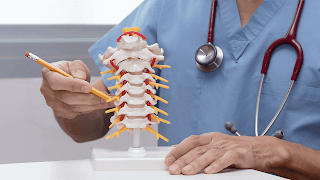The Comprehensive Overview of Spinal Laminoplasty
 |
| Spinal Laminoplasty |
The 1970s saw the development and refinement of cervical
laminoplasty in Japan as a means of treating posterior longitudinal ligament
ossification. Since then, additional research and development have been done on
a number of cervical laminoplasty techniques, and these have proven to be
successful in clinical settings. A laminoplasty is a procedure that enlarges
the spinal canal. A laminoplasty removes the hard "roof" that
frequently develops over the spinal canal. The lamina is a section of bone.
Spinal laminoplasty is a specialized surgical procedure
designed to alleviate spinal cord compression. This technique, which involves
reshaping or repositioning the lamina (the back part of a vertebra), is
increasingly recognized for its ability to create more space within the spinal
canal, thereby relieving pressure on the spinal cord and nerves. Over the
years, Spinal
Laminoplasty has become a preferred alternative to traditional
laminectomy, primarily due to its less invasive nature and the preservation of
spinal stability.
Understanding
Spinal Laminoplasty
Spinal laminoplasty was developed as an alternative to
laminectomy, which involves the complete removal of the lamina to decompress
the spinal cord. Unlike laminectomy, laminoplasty hinges on the principle of
maintaining spinal integrity by creating a "hinged door" out of the
lamina, allowing for decompression without removing significant portions of
bone. This approach helps in preserving the structural stability of the spine,
reducing the risk of post-operative complications such as spinal deformity and
instability.
The
Procedure of Spinal Laminoplasty
The procedure typically involves making an incision over the
affected area of the spine, exposing the lamina. Surgeons then create a hinge
on one side of the lamina while cutting through the other side, allowing the
lamina to swing open like a door. This action relieves pressure on the spinal
cord and nerves. To keep the lamina in its new position, surgeons use small
metal plates or bone grafts. This method effectively decompresses the spinal
canal while maintaining the integrity of the spinal column.
Advantages
of Spinal Laminoplasty
Spinal laminoplasty offers several advantages over
traditional laminectomy. Firstly, it reduces the likelihood of spinal
instability, as the lamina is not entirely removed but repositioned. Secondly,
this procedure is associated with a lower risk of post-operative spinal
deformities, particularly kyphosis, which can occur after laminectomy.
Furthermore, laminoplasty allows for better preservation of spinal muscle
attachments, contributing to a quicker recovery and less post-surgical pain.
Indications
for Spinal Laminoplasty
Spinal laminoplasty is indicated for various conditions that
cause spinal cord compression. These conditions include cervical myelopathy,
ossification of the posterior longitudinal ligament (OPLL), and other
degenerative spine diseases. It is particularly beneficial for patients with
multi-level spinal stenosis, where decompression is needed across several
vertebrae. By preserving the stability of the spine, laminoplasty provides an
effective solution for complex spinal conditions that would otherwise require
more invasive surgical interventions.
Recovery
and Rehabilitation
Recovery from spinal laminoplasty typically involves a period
of hospitalization followed by a rehabilitation program. Patients are usually
encouraged to begin gentle movements soon after surgery to promote healing and
prevent complications. Physical therapy is often recommended to strengthen the
muscles around the spine and improve flexibility. Full recovery can take
several months, during which patients gradually return to their normal
activities under the guidance of their healthcare provider.
Potential
Risks and Complications
As with any surgical procedure, spinal laminoplasty carries
certain risks and potential complications. These may include infection,
bleeding, nerve damage, and issues related to anesthesia. However, the
incidence of such complications is relatively low, especially when the
procedure is performed by an experienced spine surgeon. Long-term complications
can include re-stenosis (narrowing of the spinal canal) and issues with the
hardware used to secure the lamina. Regular follow-up appointments are crucial
to monitor the patient's progress and address any concerns promptly.
Technological
Advancements in Spinal Laminoplasty
Advancements in medical technology have significantly
enhanced the safety and efficacy of spinal laminoplasty. Innovations in imaging
techniques, such as intraoperative CT and MRI, provide surgeons with real-time
guidance during the procedure, improving accuracy and outcomes. Additionally,
the development of bioengineered materials for implants and grafts has improved
the biocompatibility and durability of the surgical constructs used in
laminoplasty. Robotic-assisted surgery is another promising area, offering
increased precision and reduced recovery times.
Future
Perspectives
The future of spinal laminoplasty looks promising with
ongoing research and development aimed at further improving the procedure.
Enhanced surgical techniques, better pre-operative planning tools, and improved
rehabilitation protocols are expected to contribute to better patient outcomes.
Moreover, as awareness about spinal health continues to grow, more patients are
likely to benefit from this less invasive yet highly effective surgical option.
Spinal laminoplasty represents a significant advancement in
the field of spine surgery. By offering a less invasive and more stable
alternative to traditional laminectomy, it provides an effective solution for
relieving spinal cord compression while preserving spinal integrity. With
continuous technological innovations and a growing understanding of spinal
health, spinal laminoplasty is set to play a pivotal role in the treatment of
complex spinal conditions, improving the quality of life for countless patients.
Get more insights on Spinal
Laminoplasty
Get more insights on Spinal
Laminoplasty



Comments
Post a Comment